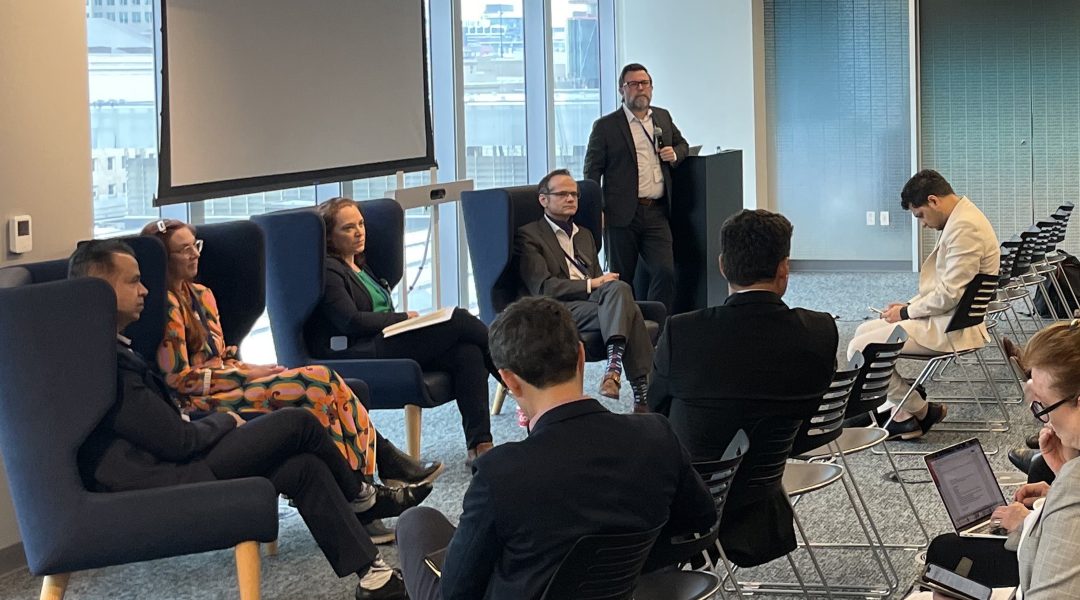
Training the AI Generation to Reimagine Canadian Companies and Classrooms
A recent study by BHER member AWS Canada shows that 66% of surveyed Canadian employers prioritize hiring talent with AI skills, and 25% are willing to pay more for those skills. But employers are struggling to find the skilled AI talent they need.
Increasingly, it’s not only tech talent they’re looking for to help them adopt, adapt to, and work with AI. It’s human skills. At the same time, survey data shows that Canadians are among the most pessimistic about AI compared to 27 other countries.
As Canada’s leading cross-sector convenor and driver of change, BHER brought our membership of business + post-secondary leaders together in March 2024 at AWS Canada’s Toronto office to discuss what it means to train the AI generation. We identified big challenges around democratization, mass adoption, productivity, and prioritizing human skills in an AI-powered world. We also see opportunities in engaging the public in tech transformation, investing in both infrastructure and people, creating inviting spaces for experiential learning, and championing the humanities.
Through our discussion, we identified the following challenges:
Democratization and mass adoption. For starters, we need AI to be broadly used. The problem: Canadians are skeptical. More so than the global average. Post-secondary institutions initially moved to ban ChatGPT and Canada’s companies, especially SMEs, are well behind the curve on adoption compared to the US and our OECD peer countries.
Productivity. It’s AI’s biggest promise. But we still have a lot to overcome to realize AI’s social and economic benefits, let alone achieve productivity gains. Conversations about how AI can do more in less time are still couched in fears of job losses and inequitable outcomes. Besides attitudinal barriers, productivity gains are also slowed by resource barriers, including availability, affordability, and access to AI chips.
AI skills are human skills. Not every team, organization, or sector will need AI developers. But everyone will need people who know how to work with AI. In-demand skills identified at our meeting include critical thinking, judgement, cross-disciplinary collaboration, adaptability, willingness to experiment, and continuous learning. We must integrate training for these skills into post-secondary in more applied ways.
But what does it mean to be human? The resurgence of interest in questions about what it means to be human can enhance both the ethics of AI use and also its effectiveness. As machine intelligence overtakes human intelligence, studying how we find meaning in life only becomes more important. Yet federal and provincial governments heavily favour STEM over social sciences, humanities, and arts (SSHA) in funding, international student/talent intake, and public discourse, with no sign of this trend changing.
Through our discussion, we also identified the following opportunities:
AI for all. Mass adoption requires attitude shifts that need to happen from the bottom up. It starts in K-12 and extends into conversations with the public. Where other countries may have more wealth and less regulations, Canada can lean into the strengths we do have—a free and open democracy—to help people feel like active participants in tech transformation. Initiatives like Amii’s Autonomous Drinking Water project help Canadians see how AI can be used to improve their everyday lives.
Productivity beyond the buzzword. Products need adopters and productivity can’t be seen as coming at the expense of humans. It may help to ensure that AI’s gains and losses align with the UN 2030 Sustainable Development Goals. Governments and NGOs also need to invest in the core infrastructure behind AI to power productivity. Countries that subsidize computing infrastructure are more successful at attracting talent and innovation. The recent announcement of a new federal investment into AI infrastructure is a step in the right direction. The majority of this funding will go towards securing access to compute capacity, and we should work to ensure that the funds for increasing adoption address the roadblocks and the fears holding people back from using AI.
Human skills must be taught. “Education, experience, and exposure” work well, including sandbox environments that allow workers to practice using new tools and incentivizing post-secondary faculty to use upskilling opportunities by seeing what their colleagues can create with AI. Organizations must provide spaces for people to try, fail, and try again. At BHER, we know that experiential learning is the best way for people to develop the human skills needed to work with and leverage AI. When it comes to AI, though, experiential learning isn’t just for post-secondary students: it’s for all of us.
Human skills also must be valued. SSHA fields have long histories of expertise in studying and teaching language, communication, and human skills. Defining our values and priorities around what we want to outsource to machines and what we humans must do for ourselves will allow us to work more effectively with AI. When more people have the skills to think through those questions, broader adoption will become easier. It’s imperative that we reverse the downward enrolment and funding trends of SSHA disciplines and training.
At BHER, we will follow through on these opportunities by holding governments accountable to their promises, advocating for more strategic investments, and working with our members to tackle AI-related challenges, including building out our research partnerships and innovation strategic pillar with a focus on AI and productivity.
Download the Thought Leadership piece